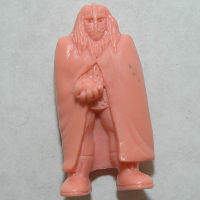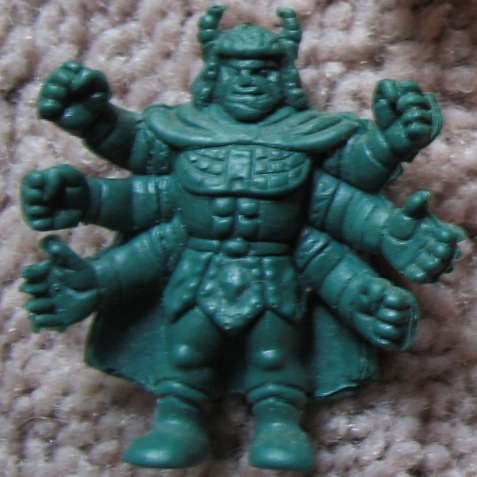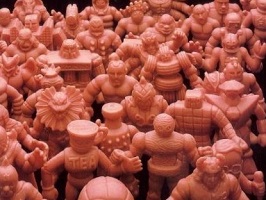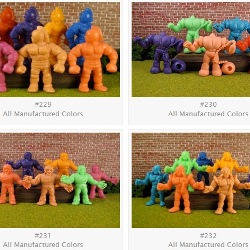However, nothing was done with it because it seemed kind of boring. It may be. But the $306 sale of some Class A figures makes it a boring idea that might be worth sharing.
The M.U.S.C.L.E. community is very small – especially in comparison to hobbies like Star Wars, Transformers, or G.I. Joe. Because of this smaller size the actions of the few can greatly impact the entire community. For example, Star Wars collectors have a large collective experience regarding the prices of their collectibles. This allows the normalization of the prices to happen muck more quickly and easily. So even if two Star Wars collectors went “crazy” and bid up one particular item well past any accepted average price it wouldn’t significantly change the accepted average price. The sheer volume of Star Wars collectors, auctions, and items protects it from outliers.
With M.U.S.C.L.E. collecting the simple, and commonly held, idea is that auctions often come down to two bidders. It is probably the defense most often cited by individuals that feel persecuted for over spending. They may say, “Hey, someone else was willing to pay that much if I didn’t!”
But the M.U.S.C.L.E. Rule of Two (MRT) is really broader than simply two bidders. It represents behavior more than two standard deviations from the mean on any M.U.S.C.L.E. topic. It is the most observable and impactful on the M.U.S.C.L.E. community during auctions and the Dr. Bombay auction served as a perfect example of this rule.
For the sake of discussion, and easy math, imagine that there are 100 M.U.S.C.L.E. collectors. When the Dr. Bombay auction first came up there were several bidders. This could be seen as the large group of 68 collectors (68% of the M.U.S.C.L.E. population). This group would have been willing to pay a few hundred dollars for the Dr. Bombay figure.As the bidding increased it soon became a much smaller population, down to 14 collectors (or 14% of the M.U.S.C.L.E. population). These are the collectors willing to aggressively go after a figure and pay more than the vast majority of collectors.
There are also 16 M.U.S.C.L.E. collectors (or 16% of the M.U.S.C.L.E. population) that probably thought the bidding had become crazy at this point. This group of collectors is unlikely to ever pay more than a few dollars for any M.U.S.C.L.E. figure.
Finally, and specifically in the case of the Dr. Bombay auction, the bidding drops down to two bidders (or 2% of the M.U.S.C.L.E. population). These two bidders may be willing to pay nearly anything to own the figure and win the auction.
It is this 2% that is allowed to shape the prices within the M.U.S.C.L.E. community. Because Dr. Bombay (and many other Alpha and Beta Non-Poster figures) has only been discovered once or, at most, a handful of times these 2% set the price of these figures because these few examples are cited as the “norm.” However, 98% of M.U.S.C.L.E. collectors would not pay these amounts. The M.U.S.C.L.E. Rule of Two.
The MRT certainly exists in all of the other aspects of the M.U.S.C.L.E. community. However, those outlying collectors do not always yield the same amount of power. The MRT could apply to:
– The degree of agreement around price.
– The percentage of collectors that like a certain figure.
– The belief in specific causes on Non-Poster figures.
That leaves those more than two standard deviations away from the mean. Those are the small amount of collectors willing to suggest potential names for nearly each Frankenstein-like Amalgam Figure (2%). And the last 2% probably hate the figures so much they simply throw them out.
The often powerful 2% begins to lose its influential power through observation and repetition. That is why lots of Flesh and Color figures have hovered near the same price point for nearly a decade. The vast majority of M.U.S.C.L.E. collectors have seen the price maintain. There is an understanding that a small percentage of collectors (2%) will always be there to overspend on those lots. But that it isn’t the norm.
The MRT does not solve anything nor does it change anything. But it does provide a paradigm that makes the unique culture of M.U.S.C.L.E. collecting a bit more understandable.





#1 by vette88 on September 5, 2012 - 11:29 am
I’m sure I’m done buying SRs, I think Jckminson is done too, so I think the price of the next one will drop dramatically. Then again, last month someone offered to buy one of mine, so we’ll see. Don’t go into the SR area unless you can sleep fine at night.
Another story could have been the Prism figure Doc had up for sale. That is the most expensive SR to date. I think there were something like 5 or so last second bidders, but still goes along with your story.
#2 by Chad Perry on September 5, 2012 - 12:29 pm
I hope you didn’t take any of the post personally. I certainly didn’t have anyone in mind as I was writing.
But the Prism Man is another great example. If you look at the bid history of the action (NOTE: I’ll have the screen capture link added when I get home from work) you’ll see the idea play out.
That 14% drive the price up pretty high and into the price range that you might expect an Alpha Non-Poster to go. The m***5 bid of $2111.77 could literally be the line of the second standard deviation. That final push of $452.68 more dollars drops out the other bidders. Hell, some people might argue the figure isn’t worth $452. But it’s at this break that the final bidders push it higher than anyone thought.
It just so happens that it was two final bidders, but I think the example is still fully illustrative of the MRT idea.
#3 by vette88 on September 5, 2012 - 1:00 pm
No, I didn’t. If my post came off wrong, I didn’t mean it. It just pretty much sums up they way I feel about the SR area. Enter at your own risk more or less.
I agree with your example.